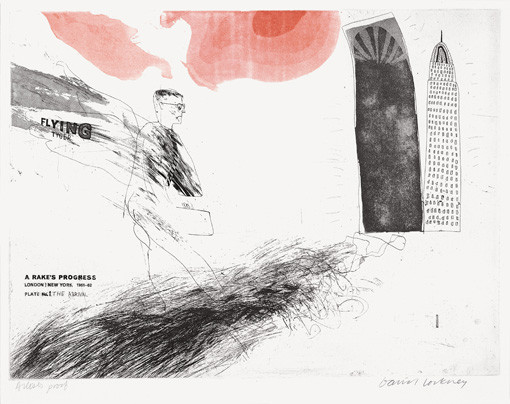David Hockney
19 Jun - 30 Sep 2012

© David Hockney
"The Arrival", 1963
Farbradierung, Blatt 1 aus: "A Rake ́s Progress. A Graphic Tale Comprising Sixteen Etchings. 1961 to 1963", London: Editions Alecto 1963, Artists Proof, Staatliche Museen zu Berlin, Kupferstichkabinett
Foto: David Hockney, Inc., Los Angeles
"The Arrival", 1963
Farbradierung, Blatt 1 aus: "A Rake ́s Progress. A Graphic Tale Comprising Sixteen Etchings. 1961 to 1963", London: Editions Alecto 1963, Artists Proof, Staatliche Museen zu Berlin, Kupferstichkabinett
Foto: David Hockney, Inc., Los Angeles
DAVID HOCKNEY
A Rake's Progress.
David Hockney's Prints from the 1960s
19 June - 30 September 2012
Born 75 years ago in Bradford, England, David Hockney first travelled to the United States in 1961, while still studying at the Royal College of Art in London. In 1963, his portfolio A Rake's Progress appeared in the renowned Editions Alecto in London. It comprises 16 two-tone etchings in which he processes his experiences in the New World with self-ironic reference to William Hogarth's 1735 moralistic cycle (eight scenes) of the same name. Hockney's hero wanders through the cycle's various images as a linear figure in profile, primarily as a bust. The distinctive physiognomy with glasses refers to the artist himself. Various levels of reality blur: personal experience (his arrival in New York), adaptations from Hogarth (allusions to prison and the mental hospital, for instance) and nightmares (when the hero disappears into the jaws of a monster, for example) are all woven together.
By 1965 Hockney had moved to Los Angeles, and that year he published A Hollywood Collection, a series of six colour lithographs done in trompe l'oeil, or illusionistic style. These were also published by Editions Alecto, and, as if they were actual oil paintings, he provided the pages with printed frames: "It's a kind of joke thing, a kind of home-made art collection with bits of everything in it, a nude, an abstract, a landscape and so on." The title evokes a fictitious painting collection in Hollywood, a kind of 'art kit' representing typical genres of European art.
In both of these early series, David Hockney, whose work is classified as English Pop Art, uses a variety of styles and content to connect the cultural achievements of old Europe with his own American experiences. With a playful sense of irony through the use of a figurative formal language, Hockney disrupts and alienates conventional image composition on a number of levels.
A Rake's Progress.
David Hockney's Prints from the 1960s
19 June - 30 September 2012
Born 75 years ago in Bradford, England, David Hockney first travelled to the United States in 1961, while still studying at the Royal College of Art in London. In 1963, his portfolio A Rake's Progress appeared in the renowned Editions Alecto in London. It comprises 16 two-tone etchings in which he processes his experiences in the New World with self-ironic reference to William Hogarth's 1735 moralistic cycle (eight scenes) of the same name. Hockney's hero wanders through the cycle's various images as a linear figure in profile, primarily as a bust. The distinctive physiognomy with glasses refers to the artist himself. Various levels of reality blur: personal experience (his arrival in New York), adaptations from Hogarth (allusions to prison and the mental hospital, for instance) and nightmares (when the hero disappears into the jaws of a monster, for example) are all woven together.
By 1965 Hockney had moved to Los Angeles, and that year he published A Hollywood Collection, a series of six colour lithographs done in trompe l'oeil, or illusionistic style. These were also published by Editions Alecto, and, as if they were actual oil paintings, he provided the pages with printed frames: "It's a kind of joke thing, a kind of home-made art collection with bits of everything in it, a nude, an abstract, a landscape and so on." The title evokes a fictitious painting collection in Hollywood, a kind of 'art kit' representing typical genres of European art.
In both of these early series, David Hockney, whose work is classified as English Pop Art, uses a variety of styles and content to connect the cultural achievements of old Europe with his own American experiences. With a playful sense of irony through the use of a figurative formal language, Hockney disrupts and alienates conventional image composition on a number of levels.
